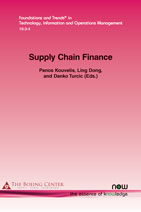Managing Inventory for a Multidivisional Firm with Cash Pooling
By Kevin Shang, Fuqua School of Business, Duke University, USA, khshang@duke.edu | Jianan Wang, School of Management, Zhejiang University, China, wangjn@zju.edu.cn | Yi Yang, School of Management, Zhejiang University, China, yangyizju@zju.edu.cn
Abstract
We consider a multi-divisional firm in which each division replenishes its inventory and the headquarter coordinates the cash flow through a master account over a finite horizon. The demands of the divisions are stochastic and may be correlated. The objective is to find an optimal joint inventory replenishment and cash retention policy which maximizes the firm’s working capital. We show that this problem is equivalent to minimizing the total system cost. Due to curse of dimensionality, the optimal policy is difficult to obtain. Nevertheless, we characterize the properties of the optimal policy and develop a simple heuristic that possesses these properties. A numerical study shows that the heuristic is near-optimal. We explore managerial insights through the heuristic. Among others, we find that the value of cash pooling is most significant when the demands of the divisions are negatively correlated.
Supply Chain Finance
Supply Chain Finance focuses is on creating liquidity in the supply chain through various Buyer or Seller-led solutions with or without a facilitating technology. The role of supply chain finance (SCF) is to optimize both the availability and cost of capital within a given buyer-supplier supply chain. To add further value, information on the physical flow of goods can be monitored. The coupling of information enables lenders to mitigate financial risk within the supply chain. The mitigation of risk allows more capital to be raised, capital to be accessed sooner, or capital to be raised at lower rates. Supply chain participants reside in diverse economic environments, are of different sizes, face a variety of uncertainties, have different bargaining powers over its trading partners, and have different accessibilities to capital markets. Many forms of financing arrangements between buyers and suppliers have emerged intending to overcome challenges in their specific economic and business environments.
Part 1 examines Supplier Financing. The three papers included in this section discuss supplier based financing issues including: motivation and rationale for supplier based financing, the optimal mix of bank financing and supplier financing, and empirical study of the impact of trade credit on firm performance. Part 2 focuses on Buyer Financing including three papers included that discuss buyer based financing issues in supply chains including the rationales of different types of buyer based financing arrangements and their impacts on supply chain performance. Part 3 reviews Inventory Models and Financing Consideration and the two papers in this part of the book explore how to coordinate the management of the cash flow and inventory flow within an organization and the relationship between a firm’s inventory policy and its cost of capital. Part 4 examines Operational Investments and Financing Issues and includes four papers that address operational investments with explicit financing considerations.

Companion
Foundations and Trends® in Technology, Information and Operations Management, Volume 10, Issue 3-4 Special Issue: Supply Chain Finance
See the other articles that are also part of this special issue.